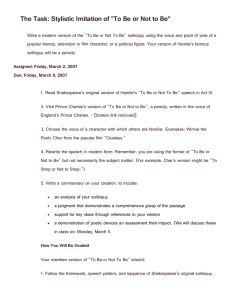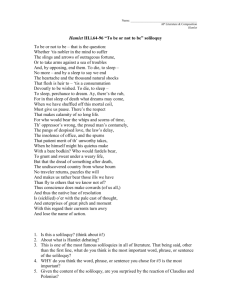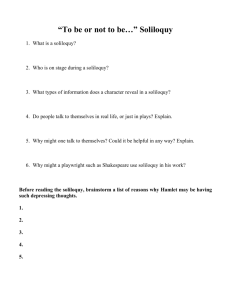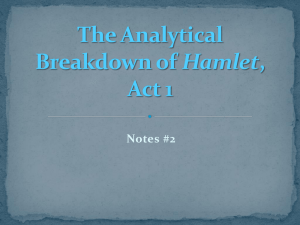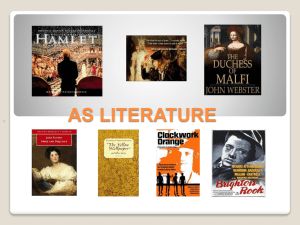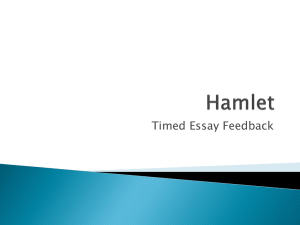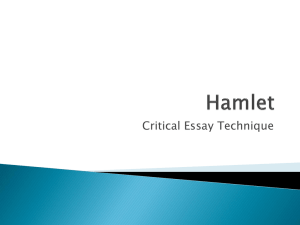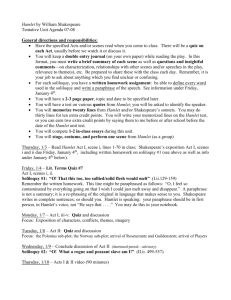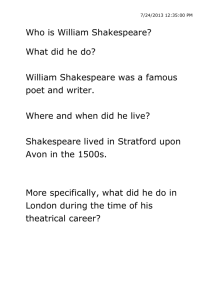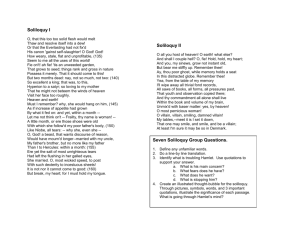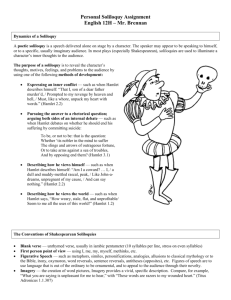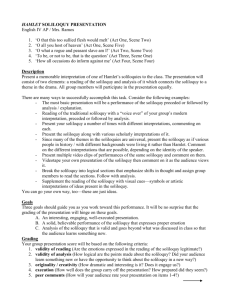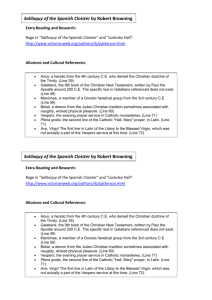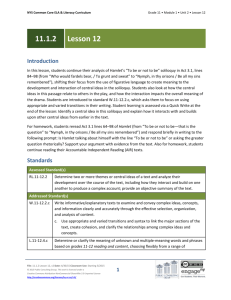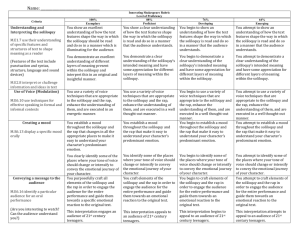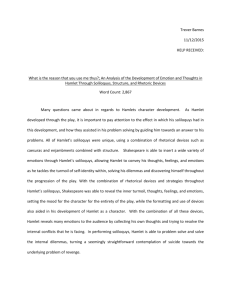English I Lesson Plan - St. Edwards University
advertisement
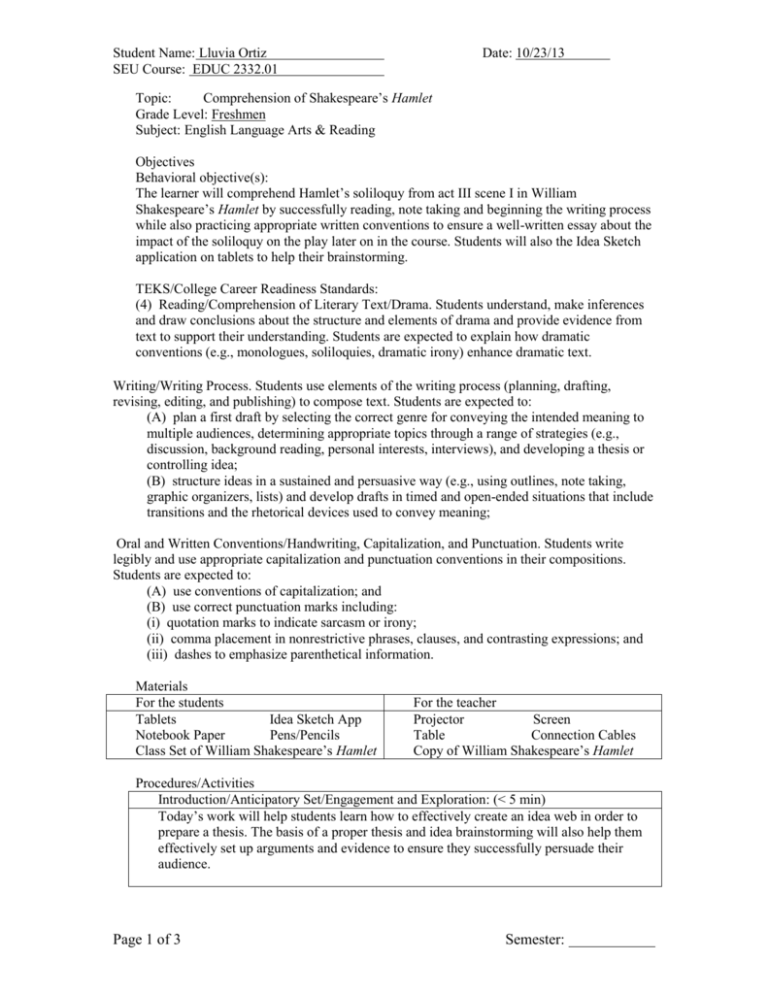
Student Name: Lluvia Ortiz SEU Course: EDUC 2332.01 Date: 10/23/13 Topic: Comprehension of Shakespeare’s Hamlet Grade Level: Freshmen Subject: English Language Arts & Reading Objectives Behavioral objective(s): The learner will comprehend Hamlet’s soliloquy from act III scene I in William Shakespeare’s Hamlet by successfully reading, note taking and beginning the writing process while also practicing appropriate written conventions to ensure a well-written essay about the impact of the soliloquy on the play later on in the course. Students will also the Idea Sketch application on tablets to help their brainstorming. TEKS/College Career Readiness Standards: (4) Reading/Comprehension of Literary Text/Drama. Students understand, make inferences and draw conclusions about the structure and elements of drama and provide evidence from text to support their understanding. Students are expected to explain how dramatic conventions (e.g., monologues, soliloquies, dramatic irony) enhance dramatic text. Writing/Writing Process. Students use elements of the writing process (planning, drafting, revising, editing, and publishing) to compose text. Students are expected to: (A) plan a first draft by selecting the correct genre for conveying the intended meaning to multiple audiences, determining appropriate topics through a range of strategies (e.g., discussion, background reading, personal interests, interviews), and developing a thesis or controlling idea; (B) structure ideas in a sustained and persuasive way (e.g., using outlines, note taking, graphic organizers, lists) and develop drafts in timed and open-ended situations that include transitions and the rhetorical devices used to convey meaning; Oral and Written Conventions/Handwriting, Capitalization, and Punctuation. Students write legibly and use appropriate capitalization and punctuation conventions in their compositions. Students are expected to: (A) use conventions of capitalization; and (B) use correct punctuation marks including: (i) quotation marks to indicate sarcasm or irony; (ii) comma placement in nonrestrictive phrases, clauses, and contrasting expressions; and (iii) dashes to emphasize parenthetical information. Materials For the students Tablets Idea Sketch App Notebook Paper Pens/Pencils Class Set of William Shakespeare’s Hamlet For the teacher Projector Screen Table Connection Cables Copy of William Shakespeare’s Hamlet Procedures/Activities Introduction/Anticipatory Set/Engagement and Exploration: (< 5 min) Today’s work will help students learn how to effectively create an idea web in order to prepare a thesis. The basis of a proper thesis and idea brainstorming will also help them effectively set up arguments and evidence to ensure they successfully persuade their audience. Page 1 of 3 Semester: Student Name: Lluvia Ortiz SEU Course: EDUC 2332.01 Date: 10/23/13 Model: I will begin by reading the soliloquy or monologue to gain a basic understanding. If I am having difficulty understanding then I will reread the piece, slowly and carefully, to ensure I understand it piece by piece. As we’re reading, students will begin inputting ideas into the Idea Sketch app. After reading, I will begin to write down key words or ideas I would like to use in my essay using the Idea Sketch app on the tablet. I will then create a thesis based on my understanding of what type of role/impact the soliloquy has in the play (positive, negative, etc.) I will search and write down evidence from the text to support my thesis. Guided Practice/Exploration: I will model the expectations of the task for the students starting with reading the soliloquy, taking notes and/or understanding the piece to develop cognitive skills. Then I will guide them in developing their social skills by sharing information with classmates in order to achieve a better understanding and insight on point to use for their essay. Finally, I will provide advice and coaching to each individual student based on their progress throughout the activity. Check for Understanding/Explanation: I will look for effort in taking notes, searching for meanings of unknown words, and connections between their written key words/ideas to create a thesis. I will also check their use of the Idea Sketch app. What do you already know about the characters in Hamlet? What do you already know about their time period? Who are the main characters and why are they important? Independent Practice/Elaboration: What kind of emotion do you get from the reading? Why do you think Shakespeare chose certain words? Can you imagine the character and their emotions as they speak in the play? Do you think the soliloquy/monologue is important to the play? Why or why not? How does it/does it not support your thesis? Closure/Evaluation: Students will finish their idea web and finalize their reading notes. I will then have the students fill out an end-of-class worksheet answering: What knowledge have you gained regarding the play? How has your understanding of the play changed? How has your opinion of Hamlet’s character changed? What unanswered questions do you have? Planned Modifications and Differentiation: Because all students learn differently and require specific accommodations I will offer different options to ensure a better understanding of the soliloquy and play. ADHD: Read the soliloquy in pieces or act out the play with classmates to promote movement and avoid restlessness. Dyslexia: Provide the play on audio and/or video and share it will all the class so the student does not feel uncomfortable being the only one needing assistance. ESL: Provide a copy of the play is possible in the language needed while having students work in groups to define words. Within the group each student would also summarize a small section to share with group members because sometimes it’s easier to understanding things verbally than through text. Assessment of Student Learning: Page 2 of 3 Semester: Student Name: Lluvia Ortiz SEU Course: EDUC 2332.01 Date: 10/23/13 I will use a checklist/rubric and a class discussion to assess students’ understanding of the text and ability to begin the writing process. The checklist/rubric will be used during the lesson as I see students progressing through the activity. The class discussion and end-ofclass worksheet will be used at the end of the lesson in order to assess their ability to attain new information regarding the play and creating an idea web. I will consider each student’s ability when assessing but will ultimately search for improvement in the student’s understanding within their idea web development. Resources: This lesson is based off curriculum from the Hamlet section in my high school English IV class. The teacher showed us different forms of Hamlet’s play, current references to the play in media and ensured we understood the play through various activities. Page 3 of 3 Semester:

